This was published 4 months ago
On the ground in Beirut, in the aftermath of airstrikes
By Christina Goldbaum and Hwaida Saad
Dahiyeh, Lebanon: There is little life left in the southern suburbs of Beirut.
Roads, typically crammed with bumper-to-bumper traffic and the deafening screech of car horns, are eerily empty.
Once-bustling sidewalks where people talked politics over coffee and tea are desolate, too. In lieu of plastic bistro chairs, there are shards of glass and jagged chunks of concrete splayed across the pavement. Nearly every shop is closed, the apartments above them vacant.
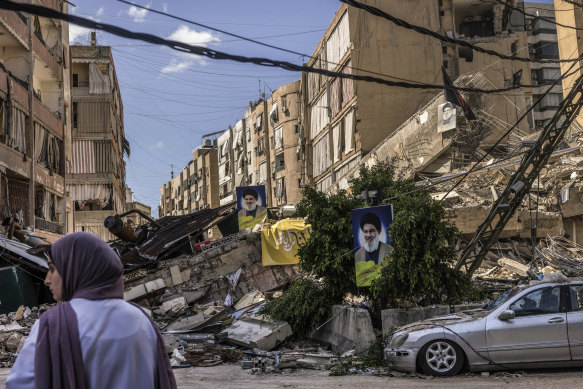
Portraits of slain Hezbollah leader Hassan Nasrallah on a destroyed street in Dahiyeh.Credit: David Guttenfelder/The New York Times
The vast majority of residents of Dahiyeh – the collection of neighbourhoods on the southern outskirts of Beirut where militant group and political party Hezbollah is the dominant power – have fled in recent days amid a barrage of Israeli airstrikes targeting the suburb. The near-daily strikes in the predominantly Shiite area have sent plumes of dark grey smoke billowing into the sky and concrete blocks of buildings crashing onto the ground, rattling people across Beirut who worry a war could soon consume the entire city.
Israeli officials say the strikes have targeted members of Hezbollah, which started firing towards Israeli positions in solidarity with its ally Hamas after the attack on Israel led by that group on October 7 last year.
Last Friday, Israeli strikes killed the leader of Hezbollah, Hassan Nasrallah, in Dahiyeh.
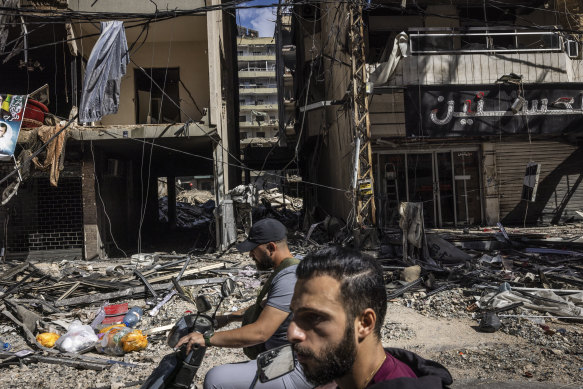
A destroyed street in Dahiyeh, the predominantly Shiite southern suburb of Beirut, after a barrage of Israeli airstrikes on Wednesday.Credit: David Guttenfelder/The New York Times
Dozens of civilians have also been killed, according to Lebanese health officials. Thousands more have fled after heeding evacuation warnings from Hezbollah, the Shiite movement that has found its most loyal and devoted support in Dahiyeh and in other Shiite villages in southern Lebanon.
Some residents who left have found refuge in relatives’ homes in other parts of Beirut. Others have been sleeping on pavements, beaches and public parks across the city.
On Wednesday, Hezbollah gave media outlets, including The New York Times, a tour of parts of Dahiyeh. Hezbollah authorities accompanied journalists to three buildings in the area that had been hit over the past two days in airstrikes. Hezbollah members were not standing near reporters as they interviewed local residents and had no say over what would be published. They did not show reporters to the site of the Israeli airstrikes that killed Nasrallah.
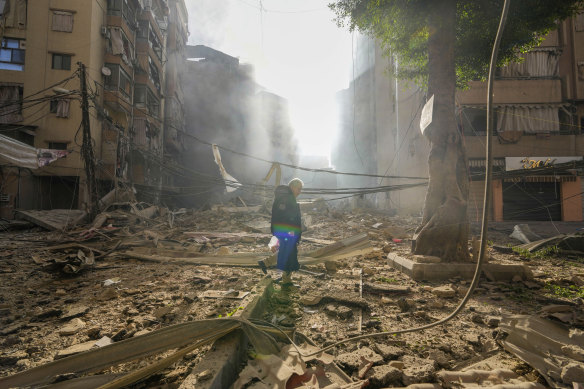
Smoke rises from the site of an Israeli airstrike in Dahiyeh, a suburb in the south of Beirut, on Thursday.Credit: AP
The tour revealed a suburb, once brimming with life, brought to a standstill. Few residents were left; those who were there had returned only for a brief visit to collect necessities – blankets, clothes, medicine – from their homes before leaving again.
Abdullah Mohammad, 35, stood on the pavement on Wednesday afternoon, looking at the piles of rubble where the offices of Al-Siraat, a television channel for cultural and religious affairs, once stood. The building had been flattened by an airstrike two days before. Now, in its place, metal poles protruded from scraps of concrete and a mangled knot of electricity lines.
“Dahiyeh is our heart,” he said, staring at the rubble. “This is where we live, this is where we are born, this is our home.”
Mohammad, whose apartment is adjacent to the building, fled to a nearby neighbourhood with his wife and two daughters late last Friday night after they heard the thundering roar of Israeli warplanes dropping more than 80 bombs over several minutes in the strikes that killed Nasrallah.
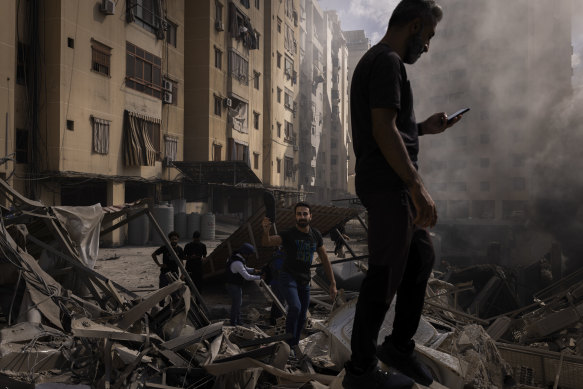
Sorting through rubble in Dahiya, the predominantly Shia southern suburbs of Beirut, after a barrage of Israeli airstrikes.Credit: NYT
Every day since, Mohammad has returned to this patch of pavement to make sure his apartment was still standing, he said. And every day as he left for Dahiyeh, his six-year-old daughter begged him to bring her some of her toys that were abandoned in the family’s scramble to flee.
He has tried to explain to her that it might not be safe to enter the building in case there is another strike. For now, he stands on the pavement, looking at his home and hoping it will stay standing another day.
Before the recent conflict broke out and the suburb emptied, Dahiyeh was among the most densely populated communities in Lebanon, with an estimated 1 million residents. Many were among the hundreds of thousands of Shiite Muslims who sought refuge there, fleeing southern Lebanon in the 1980s after Israel invaded.
During the month-long war between Israel and Hezbollah in 2006, the suburb was destroyed by Israeli airstrikes. But in the years since, Hezbollah and its patron Iran invested heavily in rebuilding it with high-end restaurants, fast-food joints, shisha lounges and sprawling malls.
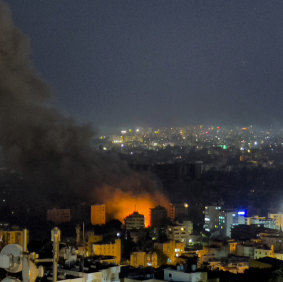
Flames and smoke rise from Israeli airstrikes in Dahiyeh, Beirut.Credit: AP
The investment breathed life back into the neighbourhood. It also shored up support for Hezbollah among many of its residents.
“Our loyalty is to you, Nasrallah!” three young men shouted on Wednesday afternoon to journalists visiting the site of another strike. “Our choice is either to fight or be humiliated — and we will not be humiliated!” they yelled.
Nearby, clouds of dark gray smoke billowed from the remains of an apartment complex that had been hit in an airstrike the night before, according to one resident from a building next door. The smoke hung thick in the air and the fire causing it seemed impossible to extinguish. “It’s still going because it’s from gas,” the resident, Bilal Salami, said. “Every time they try to extinguish it, it just reignites.”
Beneath the grayish cloud were the outlines of cinder blocks, dust-covered and dented air-conditioners and one large window frame, its metal pieces intact but glass between them shattered.
Ten minutes away on Hadi Nasrallah Highway — a road named for Nasrallah’s son who was killed fighting the Israeli army in 1997 — the sidewalk sandwich and shawarma stands were all closed, the fairy lights once strung above them dark. The stretch of road was known for its liveliness and 24-hour fast food restaurants.
Howshad Tabaja, 32, and his son, Hassan Fahik, 11, sat on his motorcycle on the side of the road late Wednesday afternoon. Tabaja fiddled with a box he had tied to the front of the bike. The box was stacked high with towels and winter coats he had just picked up from his sister’s apartment. They had all fled a few days earlier and been sleeping on the sidewalk near the city’s beachfront, he said. Now he and his son were heading back to their apartment, hoping to collect some more winter clothes.
“It’s very cold where we are staying,” he explained. Still, he said, even if his home was destroyed, it was a price he was willing to pay to resist Israel.
“I hoping to return but even if I lose my house, it’s for the sake of Sayid,” he added, referring to Nasrallah.
This article originally appeared in The New York Times.
Get a note directly from our foreign correspondents on what’s making headlines around the world. Sign up for the weekly What in the World newsletter here.